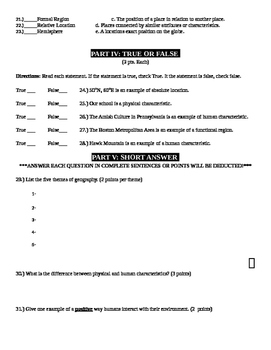

The book has even included a series of spreadsheets, accessible through a hyperlink that can be used to input data and carry out the statistical test without need to use the usual specialised software. In so doing, the book introduces them to hypotheses, probability, data and distributions that underpin their experiment and leads them through the practicalities of deriving their statistical implications. With this in mind, Professor Danny McCarroll takes his student ‘colleagues’ through the basics and reality of what is needed to do their work. To wrap up each method, the book gives worked examples, of interest to both physical and human Geographers.īecause Geographers deal with complex problems that are unlikely to yield appropriate distributions with sound, probabilistic assumptions, this book is focussed on non-parametric tests and concentrates on issues such as the inevitably unsuitable sample size, or complex and maybe extreme distributions.
#Easy geography tests how to#
Functionality persists, and the student is directed how to carry out the test in a variety of ways: manually, with a range of calculators, or with the appropriate or convenient statistical package such as SPSS. when is the statistical test useful?), and then takes the student through the rationale, and the process of how to carry out the test. It starts with the geographical question (i.e. In order to achieve this aim it is written in a most engaging fashion, directed at the student colleague, and is designed around the experiments that the students are likely to encounter in their undergraduate course. It is for budding geographers who have interesting data, collected as part of, say, an undergraduate (or even postgraduate) project, who need to derive wider meaning from their results and give their study its due significance. It is not for teachers or lecturers, and certainly not for practising statisticians. "This is an unusual and exceptional book! It is designed for geography students who want to carry out statistical tests. Parametric methods, including Student’s t-tests, correlation and regression are also covered.Īlthough aimed directly at geography students at senior undergraduate and graduate level, this book provides an accessible introduction to a wide range of statistical methods and will be of value to students and researchers in allied disciplines including Earth and environmental science, and the social sciences. The focus is on nonparametric methods that make very few assumptions and are appropriate for the kinds of data that many students will collect. Diagrams are used to guide students toward the most appropriate tests.

Introductory chapters explain how to use statistical methods and then the tests are arranged according to the type of data that they require. The aim is not to teach the mathematics behind statistical tests, but to focus on the logic, so that students can choose the most appropriate tests, apply them in the most convenient way and make sense of the results. This book is aimed directly at students of geography, particularly those who lack confidence in manipulating numbers.


 0 kommentar(er)
0 kommentar(er)
